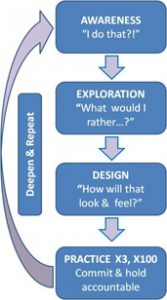In coaching my clients, I continually cycle through a simple, four-stage process: Awareness, Exploration, Design, and Practice x 3.
1. Awareness

Remember that habit is something that you’ve done repeatedly and over time, such that it operates from your subconscious. Every behavior you engage in was at one time working for you. Sometimes, what worked in the past is no longer effective – yet you’re completely unaware you’re doing it, and your system will literally filter out all data to the contrary. You become invisible to yourself.
In the coaching conversation, I will hold a mirror up to you to help you “see” what you are doing, and ask, “is this working for you, the way you want it to?”
Most people, once they become aware they have a non-productive habit/behavior, become curious to learn, “what’s a better way for me to lead?” That moves us into stage two.
2. Exploration
Here we ask many questions to understand and open up new possibilities, e.g.:
- What assessments do you hold about this situation?
- What “stories” do you tell yourself about your old behavior, and what do you want the new story to be?
- What emotional reactions do you have in ‘X’ situations, and what emotions would serve you (and others) better?
- What outcomes do you want instead?
- What are other options to achieve those outcomes?
- How do you want people to respond to you?
- What’s stopping you?
We will explore what is happening with you in three domains: Your Head (thinking, knowledge, judgments, self-talk, etc); your Heart (your emotional responses); and your Body (behavior, reaction, physical practices).
3. Design
Next, we get very specific about what that new behavior will look like, again looking at all three domains of Language, Emotion, and Body.
- What language will you use? How will you speak
- What must change in your self-talk?
- What internal shifts must you make to enable you to show up differently?
- What emotional space will you need to inhabit?
- In what ways will you embody this new behavior, language, posture, or reaction?
- What will you do?
- What resources will you access?
The new habit you design might include elements of how you think, how or what you speak, even aspects of how you sit, stand, or move. During the coaching conversation, I’ll challenge you to embody the new behavior – literally “try it on” – and tweak it till it works for you.
And don’t worry if you have no ideas … in the coaching conversation, we work together to co-create your new actions/practices!
4. Practice x3 – or x100!
Whatever you design, you must then move into a regular practice. Remember, every habit you have became such because you practiced, practiced, practiced it until it was embedded in your cells – the way you fold your arms; the way you brush your teeth; the way you listen, react, give orders, make requests, walk, sit, stand, and breathe! To create a new habit, then, you must follow the same process of Practice, Practice, and more Practice! Your success will only come thru repetition.
You see, every new thought or action lays down a new neural pathway in your brain. The more often you repeat a thought or behavior, the deeper that pathway is etched in your brain.
Metaphorically speaking, a habit is like a path in the forest that’s been walked on so many times that the ground is bare and deeply rutted. You can’t make that path go away if you keep using it. But if you forge a new/different path through the woods and take it often, the old path will slowly fill back in and grass will grow over it. You will still be able to take the path when you choose to, but it will no longer be your default – or only – route to your goal. This core cycle will repeat over and again throughout the course of your coaching engagement.
NOTE: The goal of coaching is not to create dependency – it is to support you in building a new infrastructure for your future! Our goal, by the end, is for you to have developed the skill to observe yourself through this cycle so that you can carry the benefits of coaching with you long after your engagement is complete.
